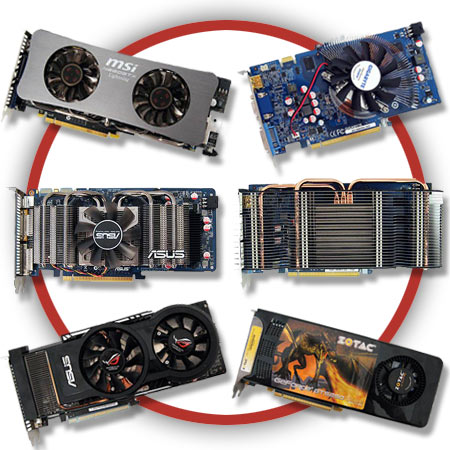GeForce 9600 GT/GTS 250/GTX 260 Non-Reference Roundup
Introduction
It’s no secret that, when it comes to buying PC components, neither the cheapest nor the most-expensive products available represent that value sweet spot where price and performance intersect. More often than not, it’s the equipment a tier or two under the bleeding-edge, high-end hardware able to offer the most best bang for your buck.
In today's graphics card market, Nvidia offers a few great products that fall within that most-attractive range. On the low end of the spectrum, the GeForce 9600 GT can be had for under $100 (though it's under heavy fire from the compelling Radeon HD 4770). It serves up reasonable performance, though. A few dollars more gets you into GeForce GTS 250 territory, which turns out to be a re-badged GeForce 9800 GTX+ with a new coat of paint, more memory, and the same great performance. At the top of the price/performance value ladder is Nvidia's GeForce GTX 260, with models coming in under $200 and providing exceptional power for that price.
Today, we will scrutinize a few GeForce cards in this range, each of which offers a unique spin compared to the reference model that Nvidia designed (the implementation that we usually review for a launch). We’re going to see unique cooling solutions, overclocks, powerful tweaking tools, and other bells/whistles associated with these cards to help each stand out from the pack and appeal to customers who want a little more than what the average model can provide.
On the plate we have: Gigabyte's GV-N96TSL-1GI, Gigabyte's GV-N96TZL-1GI, Asus' ENGTS250 Dark Knight, Zotac's GeForce GTS250 AMP! Edition, Asus' ENGTX260 Matrix, and MSI's N260GTX Lightning Black Edition. We’ve got a lot of cards and data to cover, so let’s dig in.
Get Tom's Hardware's best news and in-depth reviews, straight to your inbox.
Current page: Introduction
Next Page Gigabyte’s GV-N96TSL-1GI And GV-N96TZL-1GI: Different PersonalitiesDon Woligroski was a former senior hardware editor for Tom's Hardware. He has covered a wide range of PC hardware topics, including CPUs, GPUs, system building, and emerging technologies.
-
Mottamort I was rather disappointed with this article. Not the article itself but with the slightly misleading Title/Intro. When clicking the article I thought I was going to find a massive battle between these vendors on different tiers, instead you show us different instances of 2 slightly different cards of the same type from one vendor....if that makes senseReply
I mean you have Gigabyte vs Gigabyte in the 9600gt section, Asus vs Asus in the 250 section and so on.
:-/ -
dragonsprayer Great articleReply
i wish it had more cards, i think you need 4 parts, try some back cards like the 4870x2 darkknight? good stuff as always!
thx! -
crisisavatar wow how is the gts 250 performing so close to the gtx 260 wasn't the gtx 260 20% faster ?Reply -
enterco It's not clear to me why are you comparing '3dmark score' when you should post 'GPU score'.... It's a graphics card comparision, not platform comparision.Reply -
randomizer entercoIt's not clear to me why are you comparing '3dmark score' when you should post 'GPU score'.... It's a graphics card comparision, not platform comparision.Nothing but the cards is changed so you're not comparing platforms.Reply -
acasel We cannot see clearly the bang for the buck card there if we ain't seeing some ati cards like the 4770 and others..Reply
The drop down menu sure is fast... :-) -
enterco randomizerNothing but the cards is changed so you're not comparing platforms.Sure. A reason more to show GPU score. 3dmark score is too much influenced by CPU's power, and it's no longer relevant, the way it used to be once...Reply
By using a Quad Core and a low-performing GPU you can achive same 3dmark score as using a dual core combined with a considerably stronger GPU, 3dmark Vantage gives too much credit to CPU. But the overall FPS in games it's often higher in the second case: dual core + better GPU. -
marraco Recent review showed the 260 being neck to neck with the 4870; both in price and performance, those cards are in the same point.Reply
Since my 8800GT should be between the 9600 and the 250, I guess that the best upgrade path is to buy a second 8800GT, reaching probably 260/4870 performance.
I searched the web for 8800GT SLI benckmark running in i7 920, but got no one single review...
I think that tomshardware should review non up-to-date cards as the 8800 and the ATI equivalents, in crossfilre/SLI, since for many users, it should make sense to buy a second card that to upgrade to a 260/4870.
older reviews on those cards does not accounted for the scalability on I7 x58 platform, and probably ATI and Nvidia dedicated more time tweaking drivers for newer cards, so maybe the 8800GT does not perform well today (the SLI on core 2/Quad did not worked very well in the past)
